Rivals of Ixalan Prerelease Primer
Have you seen it? That shine?
It's glimmering over the horizon. It's what we have been searching for. It's the fabled location of our quest.
You see, Orazca is more than just a legend. Orazca is very much real.
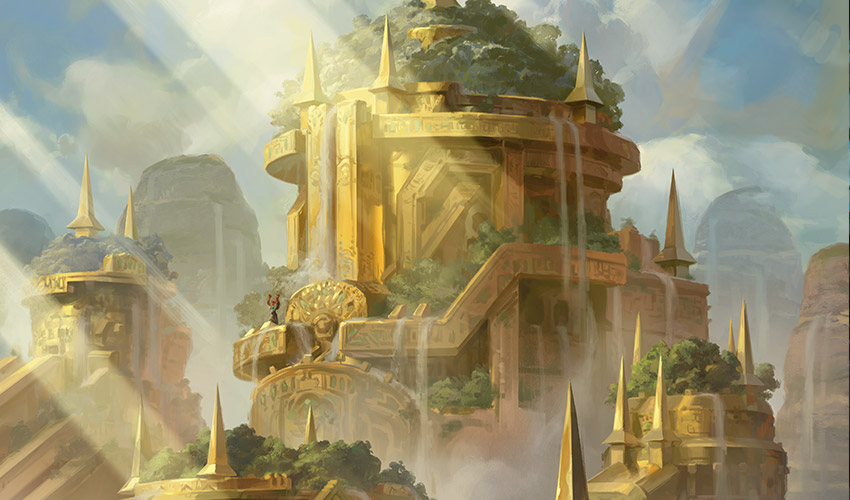
The many paths across Ixalan have all led here. Vampires. Merfolk. Pirates. The Sun Empire with all its Dinosaurs in tow. Even Vraska and Jace have made their way to Orazca.
What for? Well, the wonders that no doubt lie inside.
And you can go get your hands on these prizes before anybody else gets there at your Rivals of Ixalan Prerelease!
So where exactly can you find a Prerelease, and what exactly should you be expecting at one? Read on!
Welcome to the Jungle
Prereleases are my favorite Magic events all year.
No matter where in the world I am or what time of year it is, when a new set comes out, I always try to go check out a local Prerelease. And I'm not alone; tons of Magic fans, from seasoned veterans to first-time players, do the same! Prereleases are among the most popular events we throw.
Why? Because Prereleases are just some of the most fun you can have playing Magic!
There's nothing quite like it. You get to sit down, pick up some brand-new cards, and figure out how you want to use them at the same time everybody else is. It's an even playing field in a casual environment—where everybody shares all that bubbling energy and excitement around a new Magic set!
I visited my first Prerelease when I was just eleven and instantly fell in love with them. Seventeen years later, not much has changed!
Prereleases are great because the set is new, the footing is fairly equal as everybody plays with the set for the very first time, and you're all just relaxing and enjoying the chance to explore the new cards. It's a lot of fun for players old and new alike!
If you're a Sealed Deck veteran, you may want to skip ahead to the next section where I talk about some of the differences you can expect at your local store for Rivals of Ixalan. But if you're new to the wide world of Sealed Deck, or are maybe just looking for a few extra pointers, then read on!
All right. Let's go over perhaps the most important part: finding a place to play a Prerelease! After all, you can't very well play if you don't know where to go. How might you go about that?
If you don't already have a local shop you frequent, be sure to check out the store locator to find one near you! That store may even offer preregistration. Prereleases are some of the most popular events we put on, so be sure to check and see if the store preregisters. The best time to find out an event is full is decidedly not when you show up and learn you can't play, so be sure to look ahead.
So you've found your store. Excellent! Hopefully you managed to avoid any Merfolk traps or Dinosaur ambushes on your way.
Now it's time to explore ahead and prepare for the event. While you will be building your deck for the event with cards you're given when you get there, there's plenty to do besides that.
Be sure to pack all the supplies you will need to survive en route to the Golden City! For example, you may still want to bring a Standard deck to play for fun between rounds, a trade binder, pen and paper to keep track of life, and even a water bottle.
A Prerelease event tends to take about 4–5 hours, so make sure to set aside enough time for the entire event. And you're going to need some fuel with all of that battling, so you may want to bring something like a granola bar or apple as well to snack on. (You may want to check with the local store as well; they might even sell some food there.)
Okay now, let's see. You have a store selected on your map, and you've filled your pack with everything you'll need. You've even read through the recent Magic Story, so you're up to date on Magic lore. And, of course, you've taken a look at all the awesome cards in the Rivals of Ixalan Card Image Gallery. Perhaps, if you were curious what a tournament might be like, you've checked out my article talking about your first tournament.
You're all set! Now it's time to actually go and open up some of those cards!
Into Orazca!
When you head into the Prerelease and sit down to play, you'll be handed this wonderful item! Check out the sweet deck box this time around:
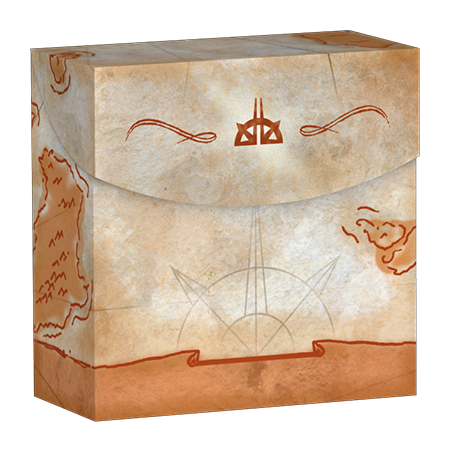
Quite wonderful—a treasure befitting Orazca itself.
You'll find a couple things inside. For example, this lovely spindown D20:
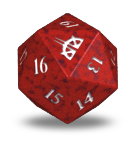
You can expect an insert telling you a little about what's going on in Rivals of Ixalan—and a little about building a Sealed deck, too:
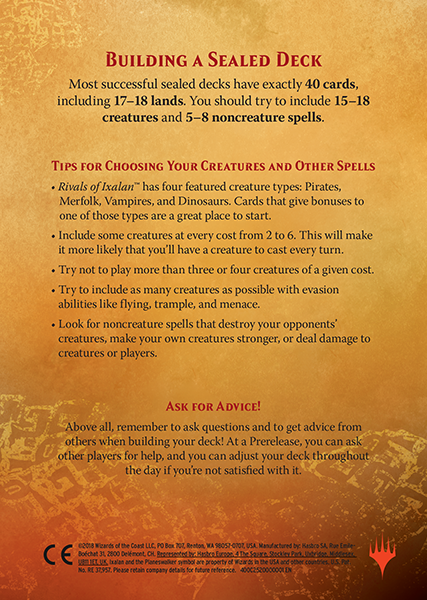
But most importantly of everything inside your Prerelease pack are the six booster packs that will give you the cards you need to build your Sealed deck, plus your shiny bonus Prerelease card. (Which could be any rare or mythic rare in the set!)
First things first: crack open those booster packs! Then you'll have a stack of cards.
So . . . what now?
It's time to build your deck, of course!
Sealed Deck is a little different from normal deck building. You get to build a deck only using the cards in front of you, plus as many basic lands as you'd like. Also, unlike a normal Constructed deck where the minimum deck size is 60, you only have to play 40 cards.
The first thing you're going to want to do is figure out a method to pick which colors you'll be playing. I recommend playing two colors.
Some things that may draw you into specific colors are:
- A really strong rare you're excited about;
- Plenty of "removal" cards that can deal with your opponent's creatures;
- A lot of playable cards in that color; and
- A good "mana curve" in that color—meaning lots of creatures of different costs.
Ideally, the colors you pick will have all four, but if two or three of those are true that's plenty good.
One key aspect of Rivals of Ixalan is that it's a "tribal" set. Tribal means that the creature types matter here. There are four primary tribes, each appearing in specific colors:
- Dinosaurs (appearing in red, green, and white);
- Merfolk (appearing in green and blue);
- Pirates (appearing in blue, black, and red); and
- Vampires (appearing in white and black).
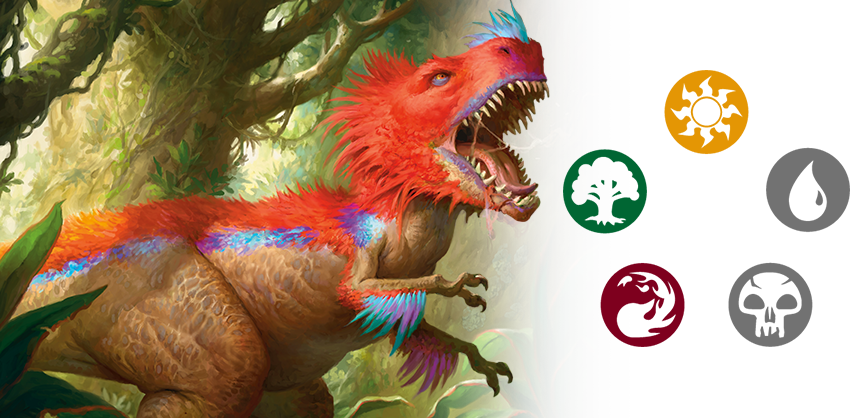
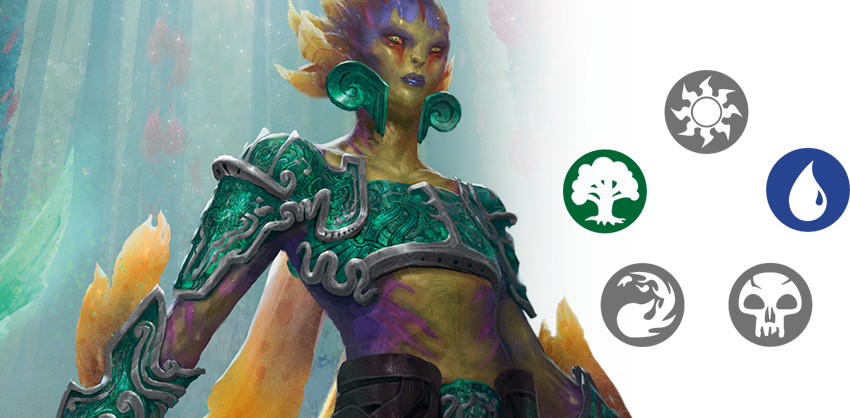
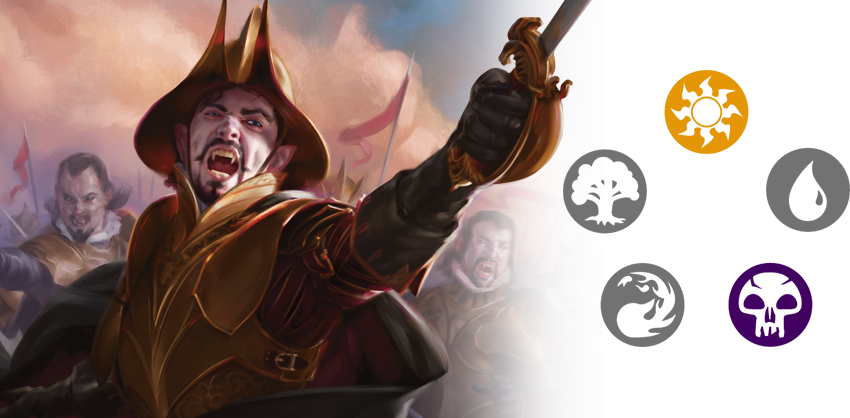
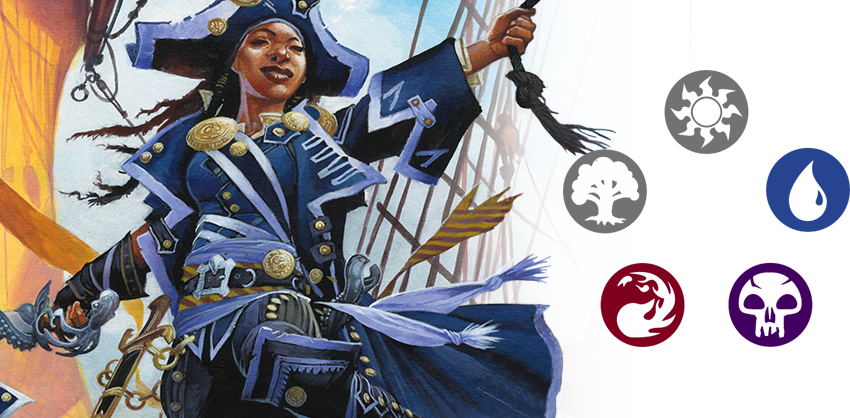
If in doubt, you will probably be just fine picking a tribe to help narrow down your choices! If you pick one of the tribes that spans three colors, I'd recommend narrowing down to two of those three colors unless you have cards that help you fix your mana.
I will note that you don't need to play a tribe, and if you don't want to, don't feel obligated. It's just one method—there are plenty of non-tribal strategies as well.
Whatever your method, you're going to need to narrow down what you're playing. If you get stuck at the Prerelease, feel free to ask the players around you for help. (You are allowed to do this at a Prerelease; everyone is there to make sure it's a fun event!)
Now you have your colors down. From there, how do you take everything you have and figure out which 22–23 cards you're going to want to put in your deck?
Here's one process that may help.
First, lay your creatures out in mana-cost order. This helps you see what creatures you're going to potentially have to cast at each part of the game. (Don't lay your noncreatures out at this point unless they're cards you are planning to play as soon as you have that much mana—for example, you will generally cast a [autocard]Fathom Fleet Captain[/autocard] on turn two, whereas [autocard]Walk the Plank[/autocard] isn't usually a turn-two play.)
A good "mana curve" of creatures is crucial to a successful Sealed deck. You don't want to have a ton of cards at any single spot in the curve. It's important for you to be able to have a good mix so you can play your cheap spells in the early game and your expensive spells in the late game. As a very general rule for Limited, I would look to play something like this:
- 1 mana: 0–2
- 2 mana: 4–6
- 3 mana: 3–5
- 4 mana: 2–4
- 5 mana 1–3
- 6-plus mana: 0–2
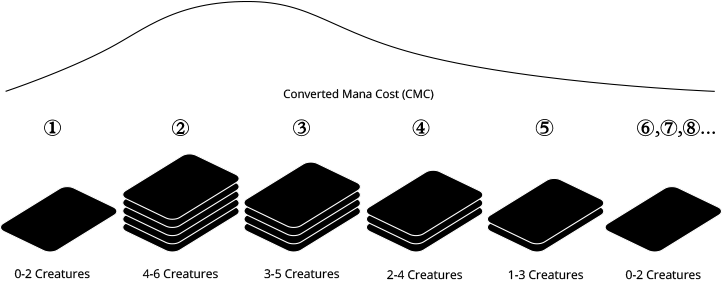
That's far from a hard and fast rule, but it's a good place to start. Cull your creatures down to these numbers by choosing your favorites.
Now that you have your core creature base figured out, it's time to add in spells! Pick your favorites among your colors to bring your deck to 22 or 23 cards, and then you're good to go from the spell side.
The spells you're going to want the most are what are called "removal spells"—these are the spells that permanently neutralize your opponent's creatures, by either dealing damage, keeping them tapped, or just straight-up destroying them. Sealed Deck Magic is all about creatures, so you'll want to play most of the cards in your colors that can get rid of your opponent's creatures.
If you want to learn more about mana curves, you can also check out my article on how to build a mana curve by clicking here.
Interested in more tips? Here are a few more things to keep in mind for deck building:
- You can play more than 40 cards, but you really should stick to 40 if possible. Every card you play past 40 just means it's that much less likely you're going to draw that awesome rare you put in your deck!
- The land ratio you're looking at should be about seventeen lands to 23 nonlands. This isn't right 100% of the time, but most Limited decks end up looking like this, and in general, it's what I would want to have.
- Play a mix of cheap-to-cast and expensive-to-cast cards. If you have all cheap, small creatures, then a single big creature can shut you down. Likewise, if you have all expensive, large creatures, you risk getting run over first. Stick to a mix that focuses on the two-, three-, four-, and five-casting-cost creatures. More games of Sealed Deck are won by casting a creature every turn starting on turn two or three than any other way.
- Evasion is important! Often, Sealed Deck games will get into stalls where both players have a lot of creatures and neither player can attack very well. Creatures with abilities like flying ensure that you can break through these creature stalls.
Two-Headed Giant
Some stores also support a version of Sealed Deck called Two-Headed Giant (often abbreviated "2HG"), where two players team up against other pairs of players. Each pair gets two Prerelease boxes, from which the players build their decks.
How does it work?
Well, the simple version is this: you and your teammate work together to build two 40-card decks. Then, you play against another pair of players in a one-game match.
How does this kind of multiplayer play out? It's simple: all your creatures and lands are separate, but you each share the same 30-point life total and take your turns simultaneously—plus you can block for each other! To do the best you can, you'll need to work together to overcome the opposition.
Curious to learn more about how 2HG works and some of the intricacies of play? Be sure to check out the page all about it by clicking here.
Open Dueling
If the idea of spending a day playing a tournament doesn't fit into how you prefer to play Magic, or if you have less time and just want to experience the adventure of Rivals of Ixalan on your own time, you can get involved in Open Dueling!
You get a ready-to-play 60-card Intro Pack and use it to do battle against others participating in Open Dueling, including players participating in the main tournament who are between rounds. This is a great way to dip your toe into the water if you aren't sure the Prerelease is something you want to do or if you can't commit 5 hours to a Prerelease event. You can just play games in Open Dueling at your own leisure. Plus, it's fun!
Ask your local store about Open Dueling at the Prerelease, and prepare to battle!
Rivals of Ixalan Mechanics
Rivals of Ixalan has all the mechanics you know and love from Ixalan, plus a new one. But the new one is a doozy, and you're going to want to check it out—make sure to take a look at ascend!
Receiving the City's Blessing
The set may be called Rivals of Ixalan, but I hope you go out there and make some friends, rather than rivals. Prereleases are a truly fantastic time.
How you play every set is a little bit different, and Rivals of Ixalan is no exception. You'll learn a lot by just going out and playing! But here's one tip: if you have a lot of ascend cards in your deck, you don't want to trade off creatures (meaning have them destroy each other in combat) because you want to hit ten permanents. If you don't have a lot of or any ascend cards in your deck, then try to aggressively trade with your opponent's creatures! You don't want them to ascend, after all.
I'll let you all discover the rest.
Take another look through the Card Image Gallery, make sure you're preregistered at your local store, and get ready to come out to the Prerelease and have fun!
Have any thoughts or questions? Wondering what to expect? I'm happy to hear from you! Feel free to send them my way. You can always get in contact with me by sending me a tweet or asking a question on my Tumblr. I'll be around!
May your adventures inside the city of Orazca be bountiful—and perhaps, if you look in the right places, you'll even find the Immortal Sun.
Enjoy!
Gavin
@GavinVerhey
GavInsight

